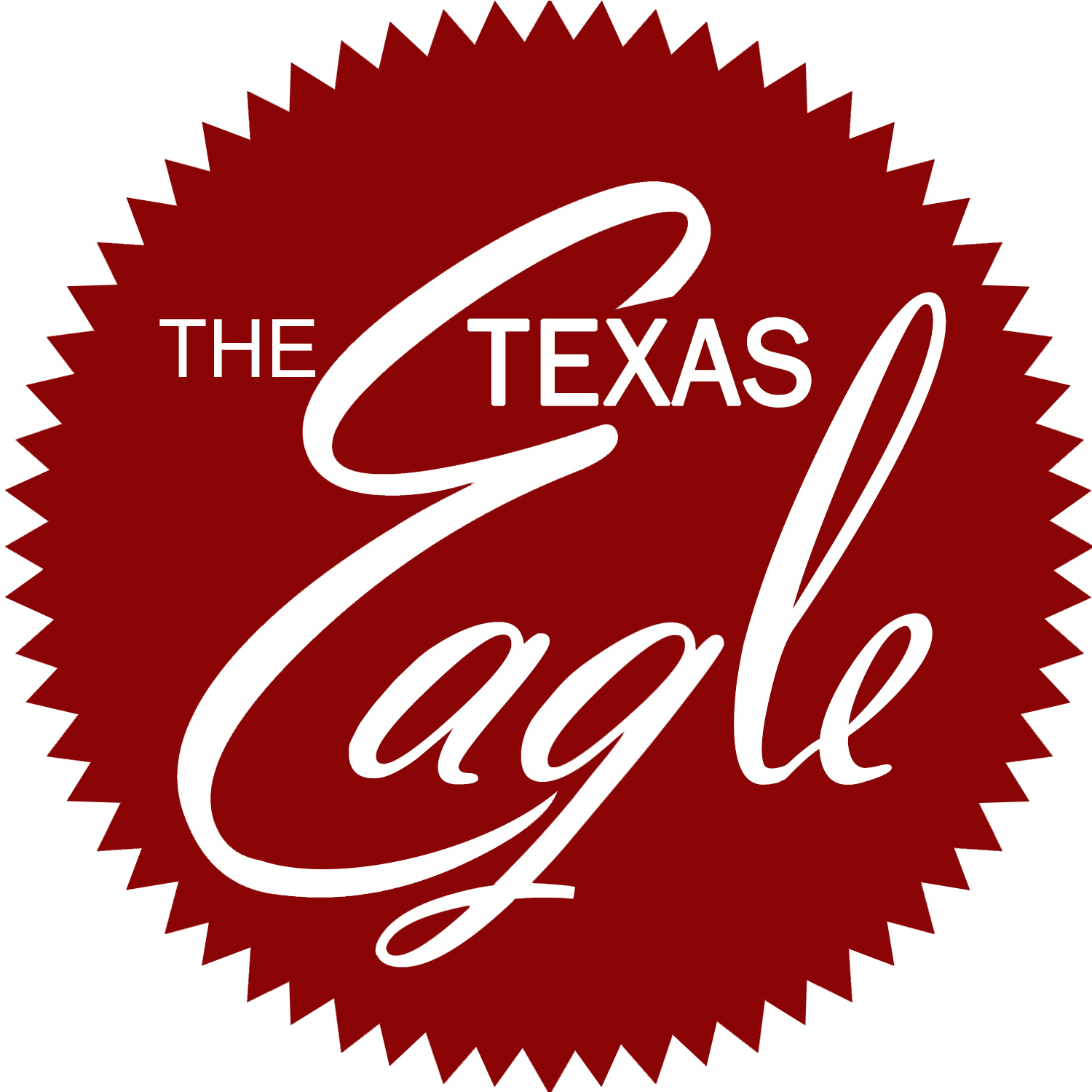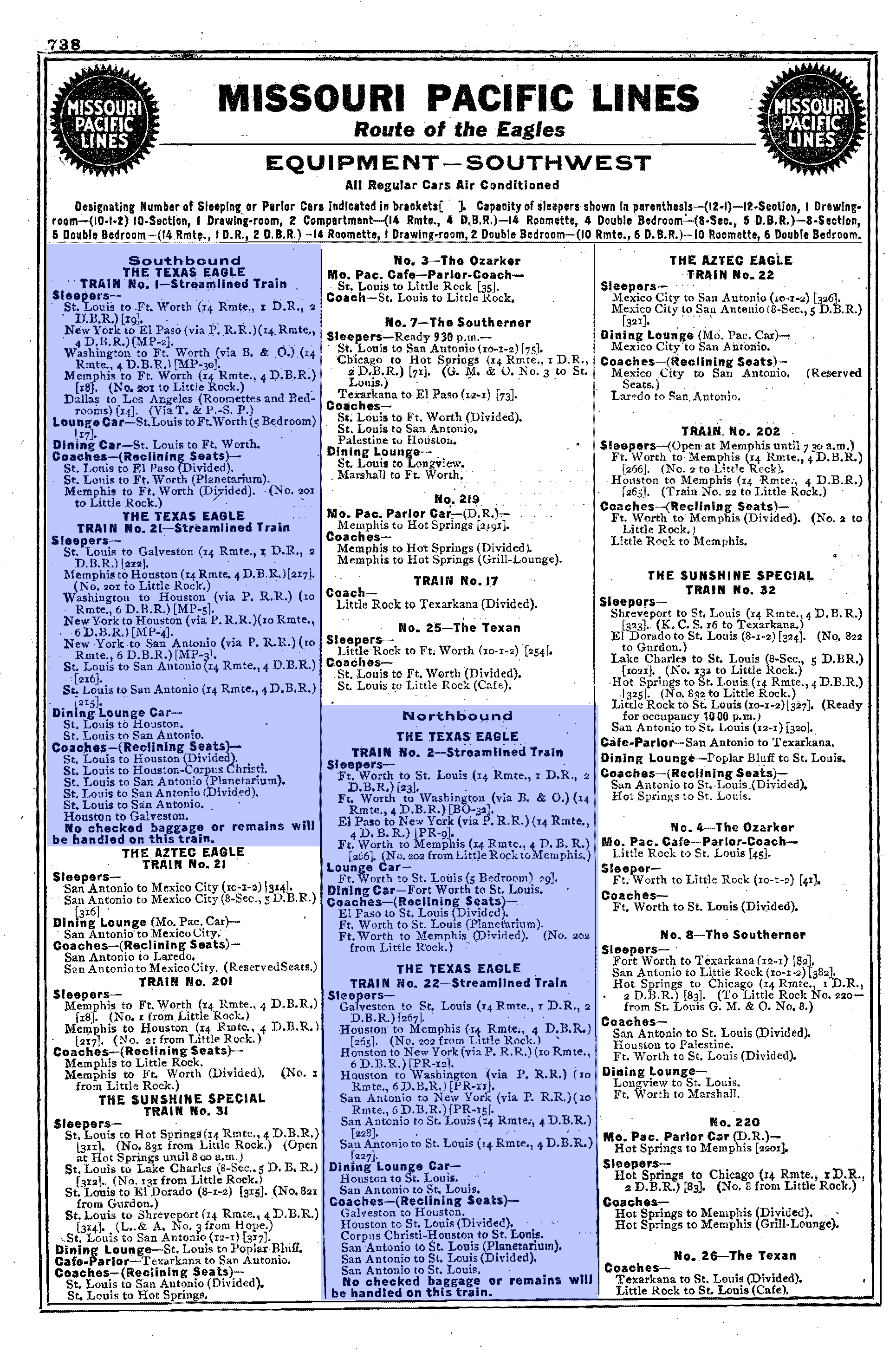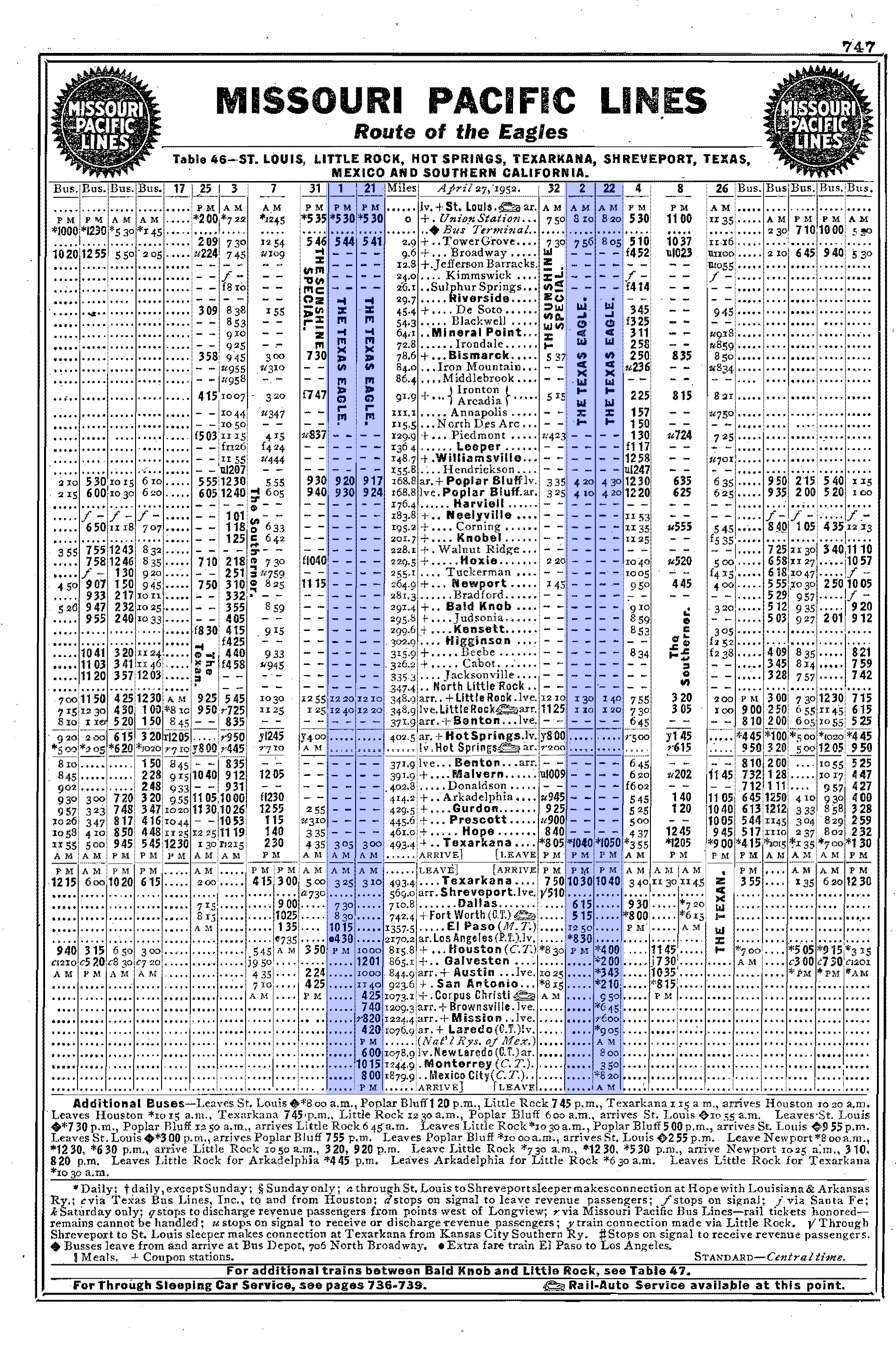"Texas Eagle" (Train): Schedule, Route Map, Timetable
Last revised: February 24, 2025
By: Adam Burns
Missouri Pacific was another classic fallen flag that had an entire
fleet of passenger trains with a common name, the Eagles. Most of these were regional in nature although two were long-distance consists, the Texas Eagle and Colorado Eagle.
While the Eagles are well remembered, particularly in the regions and cities they served the trains never carried the patronage of other famous fleets like the Union Pacific’s City trains or Southern Pacific’s Daylights.
The TE was the railroad's connection to the Midwest and Texas, serving most of the Lone Star State for over 20 years before handed over to Amtrak in the early 1970s.
Overall, the Eagles carried enough status that a few routes are still operated by Amtrak today serving Chicago, St. Louis, Dallas, and San Antonio.
Missouri Pacific, despite its chronic financial troubles, was once a dominate railroad in the Midwest. Its spiderweb of main lines and secondary corridors stretched from St. Louis to the Gulf Coast and Colorado.
In the 1960's it acquired the Chicago & Eastern Illinois for direct entry into the Windy City. To serve its many markets the railroad boasted an impressive fleet of trains.
Photos
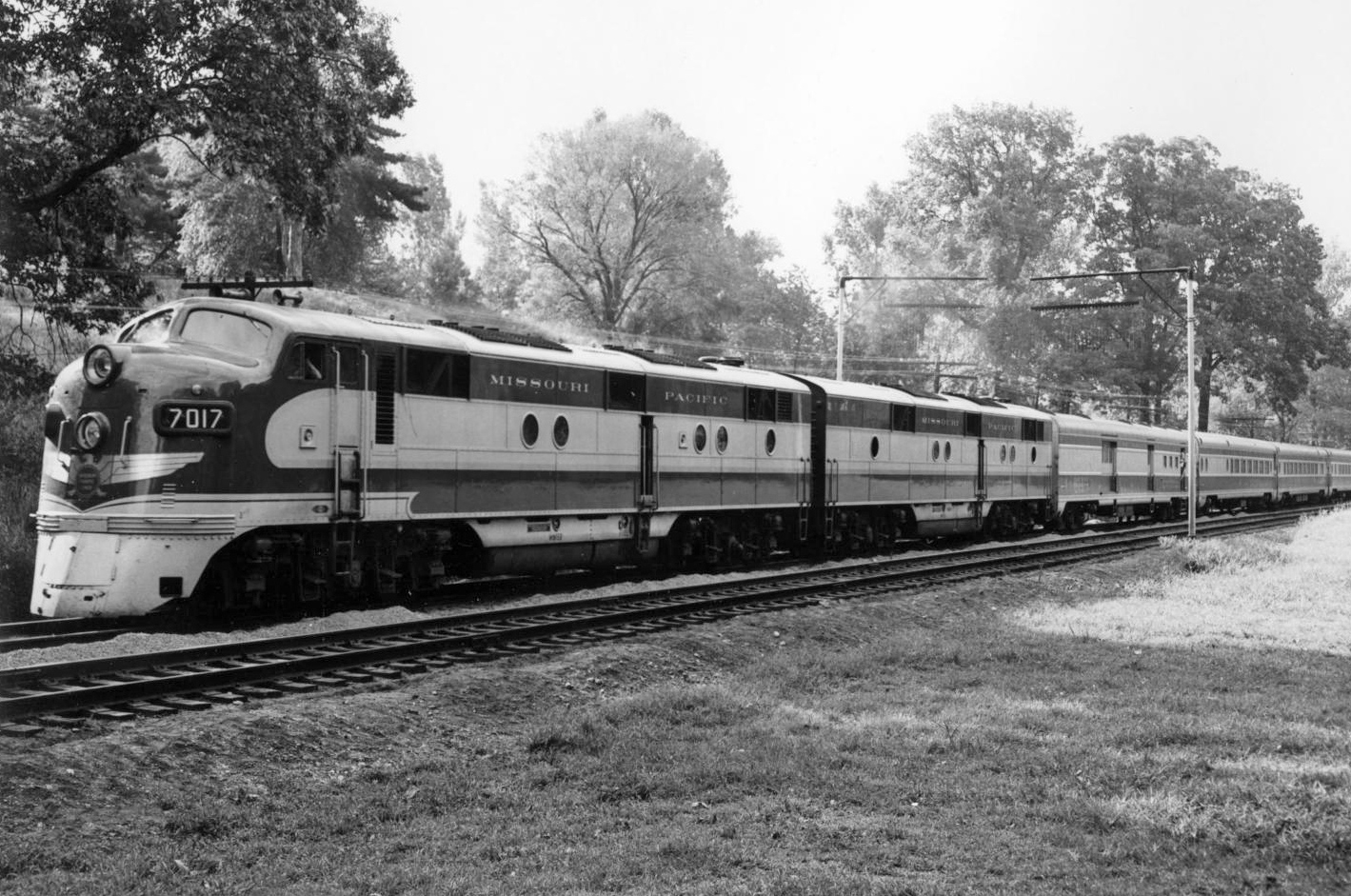 In this publicity photo, a handsome A-B set of Missouri Pacific E7's depart St. Louis with train #1, the southbound "Texas Eagle," in 1948.
In this publicity photo, a handsome A-B set of Missouri Pacific E7's depart St. Louis with train #1, the southbound "Texas Eagle," in 1948.History
The Missouri Pacific, better known by railroaders and railfans as the “MoPac,” was never a strong company financially but it was always a fighter.
The railroad's predecessors were the first to build west of the Mississippi River and would eventually come under the Jay Gould empire, who owned scores of systems in the 19th century.
By also owning the Texas & Pacific the MP reached nearly all of Texas’s major cities and by the early 20th century had stretched across eleven different Midwestern and Western states from New Orleans and Memphis to Denver, Colorado and El Paso, Texas.
For all of the railroad’s mileage and size this did not necessarily turn into substantial profits and earnings.
Herald
Between its earliest beginnings, through the mid-1950s the railroad witnessed over a half-dozen bankruptcies and reorganizations (the final occurring in 1956).
At first, the regional and (it covered almost 500 miles connecting the three cities) original Eagle was a six-car consist (with an early Electro-Motive E3 diesel for power) comprised of equipment manufactured by the American Car & Foundry. The train field a diners, lounges, and a parlor-observation.
The regional Eagle fleet reached across all stretches of the MP and enabled passengers to connect to virtually any city in the Southwest or Midwest including Houston, Brownsville, San Antonio, Mexico City (yes, Mexico City!), Memphis, Tallulah (Louisiana), Denver, and Marshall, Texas (along with the aforementioned St. Louis, Kansas City, and Omaha).
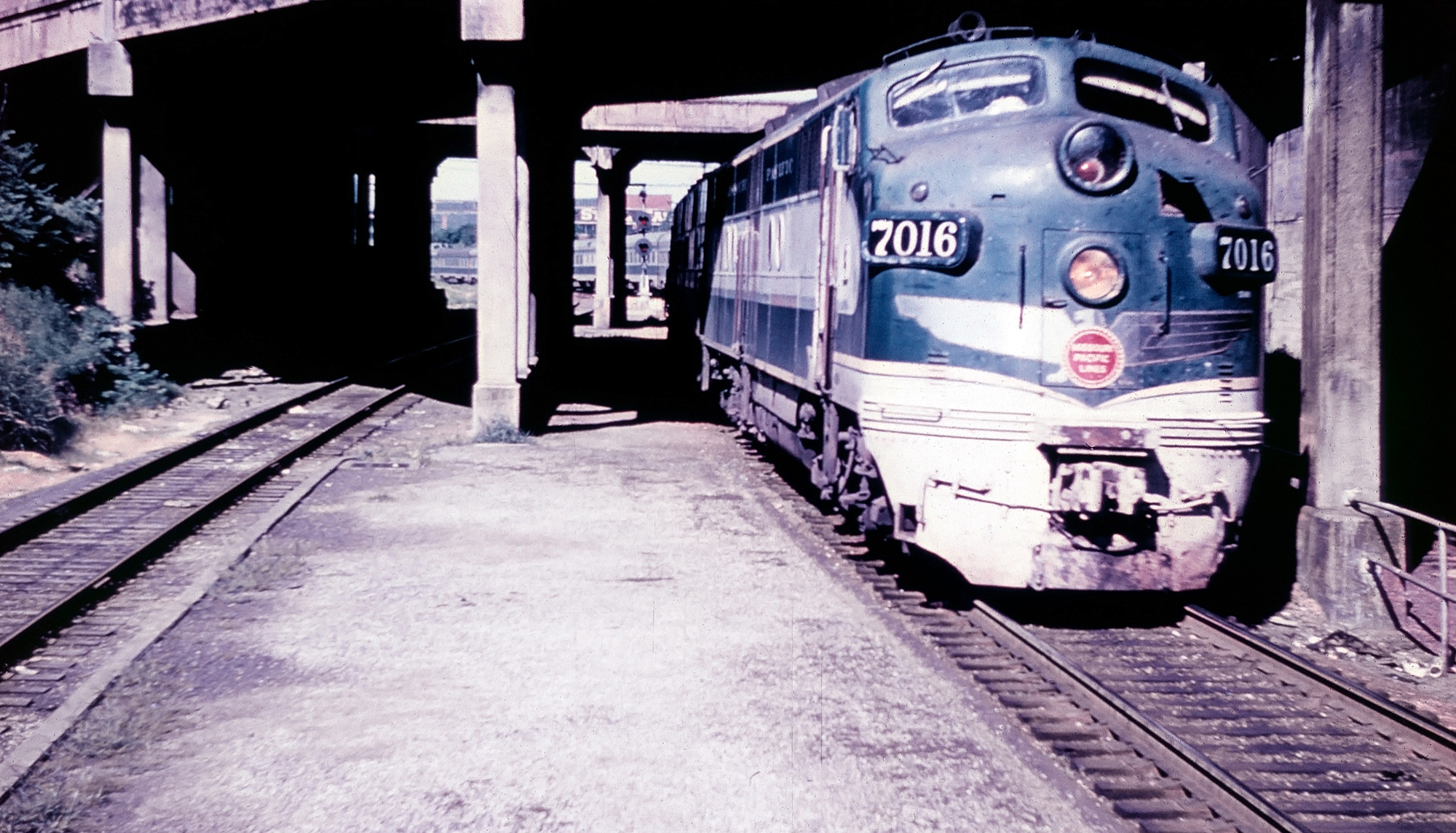 Missouri Pacific E7A #7016 has the "Texas Eagle," at Tower Grove, Missouri on June 23, 1957. American-Rails.com collection.
Missouri Pacific E7A #7016 has the "Texas Eagle," at Tower Grove, Missouri on June 23, 1957. American-Rails.com collection.The Missouri Pacific’s Texas Eagle debuted in mid-August of 1948 serving Memphis and St. Louis as well as several cities throughout Texas.
What the MoPac began as just the Eagle in March of 1940 blossomed into an entire fleet of Eagles including the Aztec Eagle, Missouri River Eagle (the original Eagle renamed), Valley Eagle, Louisiana Eagle, and Delta Eagle.
Consist (1952)
Like the rest of the fleet the TE featured dazzling designs on both its exterior and interior. All of this came from noted industrial designer Raymond Loewy (of Pennsylvania Railroad fame, among others) who gave the fleet one of the all time classic liveries featuring an intricate design of dark blue, light gray, silver, and yellow with a chromed eagle flanking the nose of the streamlined diesels.
The interior of the train featured similar colors, particularly the train’s noted dark blue with a consist featuring diner-lounges, parlor-observations, coaches with reclining chairs, Pullman service (sleepers), and later (in the early 1950s) sporting the classic Planetarium Dome (more commonly known as the Vista-Dome).
Interestingly, the TE (listed as trains #1 and #2) did not merely serve just two or three cities. From St. Louis the Texas followed a single route until it reached Longview where it “fanned out” in multiple directions serving such cities as El Paso, Dallas/Fort Worth, Palestine, Houston, Galveston, and San Antonino.
While riding aboard the train one could also reach points beyond those served by the MoPac including the East Coast via the Baltimore & Ohio and Pennsylvania at St. Louis.
Timetable (November, 1948)
| Read Down Time/Leave (Train #1/Missouri Pacific) | Milepost | Location | Read Up Time/Arrive (Train #2/Missouri Pacific) |
|---|---|---|---|
| 5:30 PM (Dp) | 0.0 | 8:15 AM (Ar) | |
| 5:44 PM | 2.9 | 7:56 AM | |
| 9:30 PM | 168.8 | 4:20 AM | |
| 12:20 AM (Ar) | 348.9 | 1:30 AM (Dp) | |
| 12:40 AM (Dp) | 348.9 | 1:10 AM (Ar) | |
| 3:10 AM (Ar) | 493.4 | 10:40 PM (Dp) | |
| Time/Leave (Train #1/Texas & Pacific) | Milepost | Location | Time/Arrive (Train #2/Texas & Pacific) |
| 3:25 AM (Dp) | 493.4 | 10:30 PM (Ar) | |
| F 3:50 AM | 517.2 | F | |
| F 4:18 AM | 544.4 | F | |
| 4:35 AM | 560.0 | 9:12 PM | |
| 5:01 AM (Ar) | 583.0 | 8:43 PM (Dp) | |
| Time/Leave (Train #1/Missouri Pacific) | Milepost | Location | Time/Arrive (Train #2/Missouri Pacific) |
| 5:01 AM (Dp) | 583.0 | 8:43 PM (Ar) | |
| 5:16 AM | 596.2 | 8:23 PM | |
| F 5:55 AM | 629.5 | F | |
| 6:09 AM | 642.5 | F 7:33 PM | |
| F 6:27 AM | 660.3 | F 7:15 PM | |
| F 6:43 AM | 675.7 | F | |
| 7:30 AM (Ar) | 710.5 | 6:15 PM (Dp) | |
| 7:55 AM (Dp) | 710.5 | 6:00 PM (Ar) | |
| 8:30 AM (Ar) | 742.0 | 5:15 PM (Dp) | |
| 9:15 AM (Dp) | 742.0 | 4:30 PM (Ar) | |
| F | 750.8 | F | |
| F | 760.0 | F | |
| F | 764.9 | F | |
| 9:57 AM | 772.8 | 3:40 PM | |
| F | 779.3 | F | |
| 10:16 AM | 787.1 | 3:13 PM | |
| F | 796.8 | F | |
| F | 803.6 | F | |
| F | 814.7 | F | |
| F | 817.9 | F | |
| 11:01 AM | 822.4 | 2:20 PM | |
| 11:26 AM | 836.9 | 1:56 PM | |
| F | 843.3 | F | |
| 11:39 AM | 846.9 | 1:37 PM | |
| 11:56 AM | 856.8 | 1:21 PM | |
| F | 869.9 | F | |
| 12:40 PM | 881.9 | 12:45 PM | |
| F | 888.2 | F | |
| 1:10 PM | 902.7 | 11:59 AM | |
| F 1:29 PM | 918.9 | 11:35 AM | |
| F | 925.5 | F | |
| 2:00 PM | 943.9 | 11:05 AM | |
| F 2:10 PM | 951.9 | F 10:47 AM | |
| F 2:21 PM | 962.7 | F 10:37 AM | |
| 2:35 PM | 971.9 | 10:26 AM | |
| 2:35 PM | 999.0 | F 9:56 AM | |
| 3:20 PM (Ar) | 1009.4 | 9:45 AM (Dp) | |
| F 3:51 PM | 1030.2 | F 9:00 AM | |
| 4:14 PM | 1049.3 | 8:30 AM | |
| 4:40 PM | 1069.5 | 8:07 AM | |
| 5:20 PM | 1105.4 | 7:25 AM | |
| F 5:35 PM | 1119.8 | F 7:07 AM | |
| F 5:51 PM | 1136.4 | F 6:52 AM | |
| 6:00 PM | 1142.9 | 6:45 AM | |
| 6:30 PM | 1162.1 | 6:25 AM | |
| 7:42 PM | 1231.4 | 4:58 AM | |
| F 8:35 PM | 1264.5 | F 4:10 AM | |
| 9:45 PM (Ar) | 1356.9 | 12:30 AM (Dp) | |
| Time/Leave (Train #21/South Texas Eagle) | Milepost | Location | Time/Arrive (Train #22/South Texas Eagle) |
| 4:50 AM (Dp) | 583 | 9:00 PM (Ar) | |
| F 5:05 AM | 595 | F 8:39 PM | |
| F 5:34 AM | 619 | F 8:11 PM | |
| F 5:54 AM | 637 | F 7:50 PM | |
| 6:30 AM (Ar) | 664 | 7:15 PM (Dp) | |
| Time/Leave (Train #25/Houston-Galveston Section) | Milepost | Location | Time/Arrive (Train #26/Houston-Galveston Section) |
| 6:50 AM (Dp) | 664 | 6:55 PM (Ar) | |
| F 7:20 AM | 689 | F 6:24 PM | |
| F 7:34 AM | 702 | F 6:09 PM | |
| F 8:06 AM | 730 | F 5:40 PM | |
| F 9:02 AM | 776 | F 4:51 PM | |
| 10:00 AM (Ar) | 815 | 4:00 PM (Dp) | |
| 10:25 AM (Dp) | 815 | 3:25 PM (Ar) | |
| 10:50 AM | 826 | 2:57 PM | |
| 10:56 AM | 830 | 2:52 PM | |
| 11:06 AM | 837 | 2:42 PM | |
| 11:10 AM | 840 | 2:38 PM | |
| 11:16 AM | 844 | 2:32 PM | |
| 11:27 AM | 852 | 2:23 PM | |
| 11:50 AM (Ar) | 865 | 2:00 PM (Dp) | |
| Time/Leave (Train #25/San Antonio Section) | Milepost | Location | Time/Arrive (Train #26/San Antonio Section) |
| 6:45 AM (Dp) | 664 | 6:55 PM (Ar) | |
| F 8:22 AM | 754 | F 5:18 PM | |
| 9:23 AM | 809 | 4:22 PM | |
| 10:10 AM | 844 | 3:40 PM | |
| F 10:47 AM | 874 | 2:59 PM | |
| F 11:06 AM | 892 | 2:39 PM | |
| 11:36 AM | 920 | 2:07 PM | |
| 11:45 AM (Dp) | 923 | 2:00 PM (Ar) |
With numerous connections and through sleepers available its timetable and scheduling could be a bit confusing to say the least.
Aside from through connections available one could also ride the Southern Pacific to Los Angeles via El Paso and even Mexico City aboard the National Railways of Mexico via Laredo!
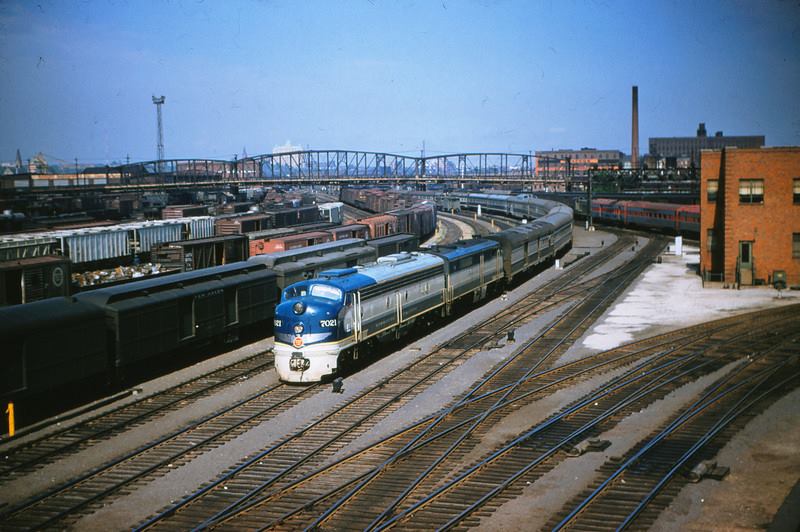 Missouri Pacific E8A #7021 and PA-2 #8017 lead the northbound "Texas Eagle," into St. Louis Union Station on May 19, 1956. Photographer unknown.
Missouri Pacific E8A #7021 and PA-2 #8017 lead the northbound "Texas Eagle," into St. Louis Union Station on May 19, 1956. Photographer unknown.Despite having so many
different connections the Texas could usually complete any segment of
its journey under 20 hours averaging anywhere between 45 and 50 mph.
Along with the Texas the entire fleet reached far and wide enabling passengers to connect to virtually any city in the Southwest or Midwest including Houston, Brownsville, San Antonio, Mexico City, Memphis, Tallulah (Mississippi), Denver, and Marshall, Texas (along with the aforementioned St. Louis, Kansas City, and Omaha).
Timetable (1952)
Despite this vast network the MoPac was plagued, like most other railroads, with ridership losses due to outside competition.
In the early 1960s mounting red ink forced the MoPac to downgrade or discontinue many of its regional services although fragments limped on until Amtrak took over intercity passenger train operations in 1971.
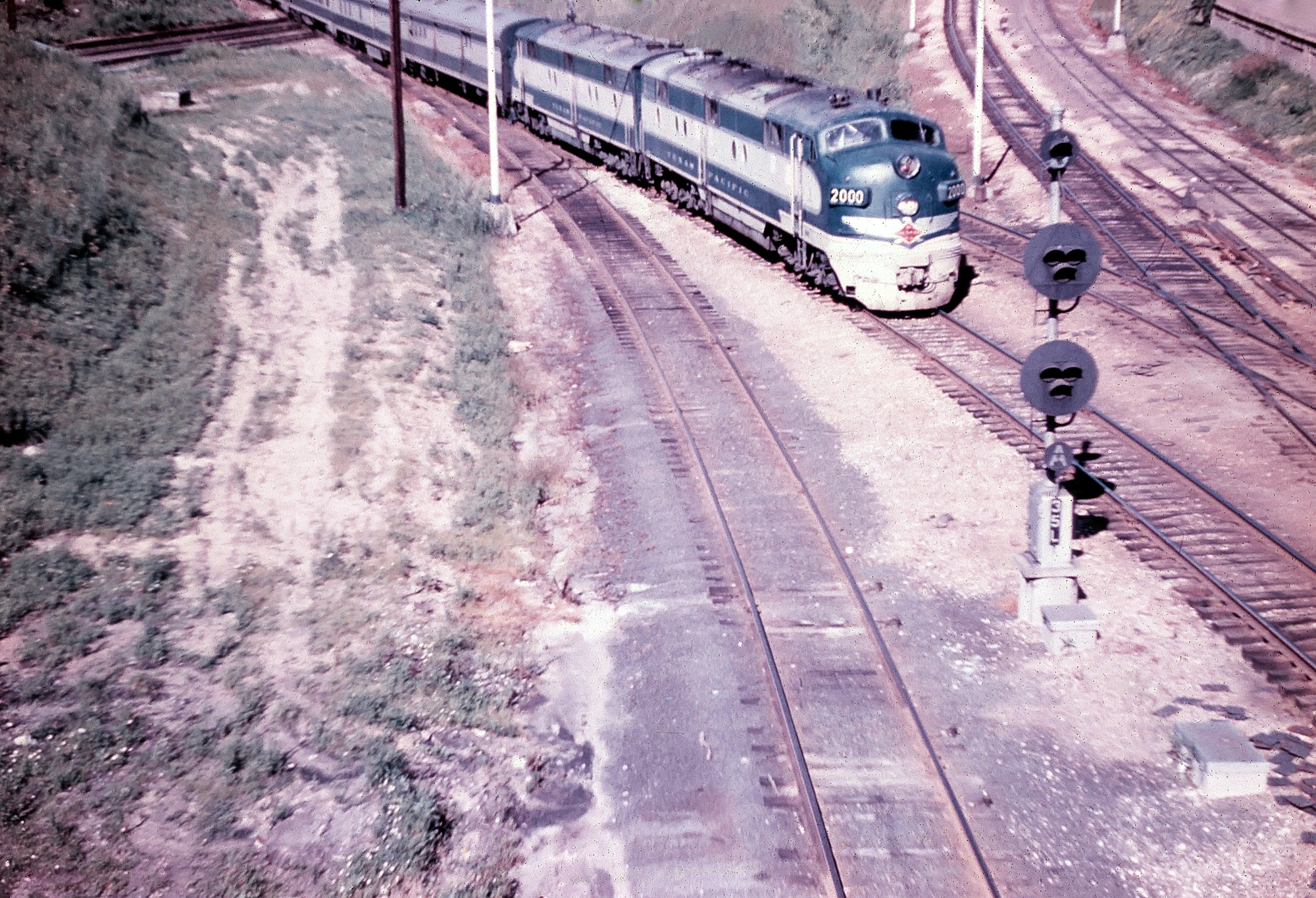 A pair of handsome Missouri Pacific E7A's, led by #2000, have the first section of the "Texas Eagle," at Tower Grove, Missouri circa 1957. American-Rails.com collection.
A pair of handsome Missouri Pacific E7A's, led by #2000, have the first section of the "Texas Eagle," at Tower Grove, Missouri circa 1957. American-Rails.com collection.Amtrak
By the late 1960s the long-distance Texas and Colorado Eagles were not immune from the cutbacks.
By 1970 the Texas had lost all-Pullman status (thus reaching eastern points via the Pennsylvania and Baltimore & Ohio railroads was no longer an option) and had become a diminutive coach-only train between St. Louis and Texarkana.
Despite this it continued to field a few sleepers, a diner, diner-coach, and reclining seat coaches. It was discontinued initially with the start of Amtrak but rejoined the timetable in October of 1981.
Sources
- Burns, A.J. and Dawson, Leslie. Official Guide Of The Railways And Steam Navigation Lines Of The United States, Porto Rico, Canada, Mexico, and Cuba, The. Volume 85. Issue 3. Pages 726-755. New York: National Railway Publication Company, 1952.
- Miner, Craig H. Rebirth Of The Missouri Pacific, 1956-1984, The. College Station: Texas A&M University Press, 1983.
- Schafer, Mike. More Classic American Railroads. Osceola: MBI Publishing, 2000.
- Schafer, Mike and Welsh, Joe. Streamliners, History of a Railroad Icon. St. Paul: MBI Publishing, 2003.
Recent Articles
-
Maryland's - Wine Tasting - Train Rides
Jan 15, 26 02:59 PM
This article delves into the enchanting world of wine tasting train experiences in Maryland, providing a detailed exploration of their offerings, history, and allure. -
Colorado's - Wine Tasting - Train Rides
Jan 15, 26 02:46 PM
To truly savor these local flavors while soaking in the scenic beauty of Colorado, the concept of wine tasting trains has emerged, offering both locals and tourists a luxurious and immersive indulgenc… -
Iowa ~ Wine Tasting ~ Train Rides
Jan 15, 26 02:36 PM
The state not only boasts a burgeoning wine industry but also offers unique experiences such as wine by rail aboard the Boone & Scenic Valley Railroad. -
Georgia's Wine Train Rides In Cordele!
Jan 15, 26 02:26 PM
While the railroad offers a range of themed trips throughout the year, one of its most crowd-pleasing special events is the Wine & Cheese Train—a short, scenic round trip designed to feel like a t… -
Indiana ~ Murder Mystery ~ Dinner Train Rides
Jan 15, 26 02:22 PM
This piece explores the allure of murder mystery trains and why they are becoming a must-try experience for enthusiasts and casual travelers alike. -
Ohio ~ Murder Mystery ~ Dinner Train Rides
Jan 15, 26 02:10 PM
The murder mystery dinner train rides in Ohio provide an immersive experience that combines fine dining, an engaging narrative, and the beauty of Ohio's landscapes. -
Nevada Dinner Train Rides In Ely!
Jan 15, 26 02:01 PM
If you’ve ever wished you could step through a time portal into the hard-working world of a 1900s short line the Nevada Northern Railway in Ely is about as close as it gets. -
Michigan Dinner Train Rides In Owosso!
Jan 15, 26 09:46 AM
The Steam Railroading Institute is best known as the home of Pere Marquette #1225 and even occasionally hosts a dinner train! -
Arizona's - Wine Tasting - Train Rides
Jan 14, 26 02:04 PM
For those who want to experience the charm of Arizona's wine scene while embracing the romance of rail travel, wine tasting train rides offer a memorable journey through the state's picturesque landsc… -
Arkansas's - Wine Tasting - Train Rides
Jan 14, 26 01:57 PM
This article takes you through the experience of wine tasting train rides in Arkansas, highlighting their offerings, routes, and the delightful blend of history, scenery, and flavor that makes them so… -
Tennessee ~ Murder Mystery ~ Dinner Train Rides
Jan 14, 26 01:42 PM
Amidst the rolling hills and scenic landscapes of Tennessee, an exhilarating and interactive experience awaits those with a taste for mystery and intrigue. -
California ~ Murder Mystery ~ Dinner Train Rides
Jan 14, 26 01:26 PM
When it comes to experiencing the allure of crime-solving sprinkled with delicious dining, California's murder mystery dinner train rides have carved a niche for themselves among both locals and touri… -
Illinois ~ Murder Mystery ~ Dinner Train Rides
Jan 14, 26 01:13 PM
Among Illinois's scenic train rides, one of the most unique and captivating experiences is the murder mystery excursion. -
Vermont's - Murder Mystery - Dinner Train Rides
Jan 14, 26 12:57 PM
There are currently murder mystery dinner trains offered in Vermont but until recently the Champlain Valley Dinner Train offered such a trip! -
Massachusetts Dinner Train Rides On Cape Cod!
Jan 14, 26 12:20 PM
The Cape Cod Central Railroad (CCCR) has carved out a special niche by pairing classic New England scenery with old-school hospitality, including some of the best-known dining train experiences in the… -
Maine Dinner Train Rides In Portland!
Jan 14, 26 11:31 AM
While this isn’t generally a “dinner train” railroad in the traditional sense—no multi-course meal served en route—Maine Narrow Gauge does offer several popular ride experiences where food and drink a… -
Kentucky Dinner Train Rides In Bardstown!
Jan 13, 26 01:14 PM
The essence of My Old Kentucky Dinner Train is part restaurant, part scenic excursion, and part living piece of Kentucky rail history. -
Kansas Dinner Train Rides In Abilene!
Jan 13, 26 12:44 PM
If you’re looking for a heritage railroad that feels authentically Kansas—equal parts prairie scenery, small-town history, and hands-on railroading—the Abilene & Smoky Valley Railroad (A&SV) delivers. -
Michigan ~ Murder Mystery ~ Dinner Train Rides
Jan 13, 26 11:24 AM
Among the lesser-known treasures of this state are the intriguing murder mystery dinner train rides—a perfect blend of suspense, dining, and scenic exploration. -
Virginia's - Murder Mystery - Dinner Train Rides
Jan 13, 26 11:11 AM
Among the state's railroad attractions, murder mystery dinner trains stand out as a captivating fusion of theatrical entertainment, fine dining, and scenic travel. -
Arizona Dinner Train Rides At The Grand Canyon!
Jan 13, 26 10:59 AM
While the Grand Canyon Railway does not offer a true, onboard dinner train experience it does offer several upscale options and off-train dining. -
Georgia Dinner Train Rides In Nashville!
Jan 13, 26 10:27 AM
If you’ve ever wished you could slow down, trade traffic for jointed rail, and let a small-town landscape roll by your window while a hot meal is served at your table, the Azalea Sprinter delivers tha… -
Indiana Valentine's Train Rides
Jan 12, 26 04:27 PM
If you’ve ever wished you could step into a time when passenger trains were a Saturday-night treat and a whistle echoing across farm fields meant “adventure,” the Nickel Plate Express delivers that fe… -
Ohio Valentine's Train Rides!
Jan 12, 26 04:20 PM
The Hocking Valley Scenic Railway offers one of the region’s most atmospheric ways to experience the Hocking Hills area: from the rhythmic click of jointed rail to the glow of vintage coaches rolling… -
Wisconsin's - Wine Tasting - Train Rides
Jan 12, 26 03:10 PM
Wisconsin might not be the first state that comes to mind when one thinks of wine, but this scenic region is increasingly gaining recognition for its unique offerings in viticulture. -
California's - Wine Tasting - Train Rides
Jan 12, 26 02:34 PM
This article explores the charm, routes, and offerings of these unique wine tasting trains that traverse California’s picturesque landscapes. -
Wisconsin Scenic Train Rides In North Freedom!
Jan 12, 26 02:20 PM
The Mid-Continent Railway Museum is a living-history museum built around the sights, sounds, and everyday rhythms of small-town and shortline railroading in the early 20th century, what the museum cal… -
Vermont Scenic Train Rides In Burlington!
Jan 12, 26 01:18 PM
Today, GMRC is best known by many travelers for its Burlington-based passenger experiences—most famously the Champlain Valley Dinner Train and the sleek, limited-capacity Cocktails on the Rails. -
Maryland's - Murder Mystery - Dinner Train Rides
Jan 12, 26 01:03 PM
Maryland is known for its scenic landscapes, historical landmarks, and vibrant culture, but did you know that it’s also home to some of the most thrilling murder mystery dinner trains? -
Minnesota's - Murder Mystery - Dinner Train Rides
Jan 12, 26 12:17 PM
Murder mystery dinner trains offer an enticing blend of suspense, culinary delight, and perpetual motion, where passengers become both detectives and dining companions on an unforgettable journey. -
Vermont Dinner Train Rides In Burlington!
Jan 12, 26 12:09 PM
There is one location in Vermont hosting a dedicated dinner train experience at the Green Mountain Railroad. -
Connecticut Dinner Train Rides In Essex!
Jan 12, 26 10:39 AM
Connecticut's rail heritage can be traced back to the industry's earliest days and a few organizations preserve this rich history by offering train rides. The Essex Steam Train also hosts dinner-theme… -
Florida Scenic Train Rides In Parrish!
Jan 11, 26 10:26 PM
The Florida Railroad Museum (FRRM) in Parrish offers something increasingly rare in today’s rail landscape: a chance to ride historic equipment over a surviving fragment of an early-20th-century mainl… -
California's - Wine Tasting - Train Rides
Jan 11, 26 02:28 PM
This article explores the charm, routes, and offerings of these unique wine tasting trains that traverse California’s picturesque landscapes. -
Georgia's - Murder Mystery - Dinner Train Rides
Jan 11, 26 02:07 PM
In the heart of the Peach State, a unique form of entertainment combines the thrill of a murder mystery with the charm of a historic train ride. -
Colorado ~ Murder Mystery ~ Dinner Train Rides
Jan 11, 26 01:43 PM
Nestled among the breathtaking vistas and rugged terrains of Colorado lies a unique fusion of theater, gastronomy, and travel—a murder mystery dinner train ride. -
Minnesota Dinner Train Rides In Duluth!
Jan 11, 26 01:32 PM
One of the best ways to feel the region's history in motion today is aboard the North Shore Scenic Railroad (NSSR), which operates out of Duluth’s historic depot. -
Illinois Dinner Train Rides At Monticello!
Jan 11, 26 12:42 PM
The Monticello Railway Museum (MRM) is one of those places that quietly does a lot: it preserves a sizable collection, maintains its own operating railroad, and—most importantly for visitors—puts hist… -
Alabama's - Wine Tasting - Train Rides
Jan 10, 26 09:29 AM
While the state might not be the first to come to mind when one thinks of wine or train travel, the unique concept of wine tasting trains adds a refreshing twist to the Alabama tourism scene. -
Maryland Dinner Train Rides At WMSR!
Jan 10, 26 09:13 AM
The Western Maryland Scenic Railroad (WMSR) has become one of the Mid-Atlantic’s signature heritage operations—equal parts mountain railroad, living museum, and “special-occasion” night out. -
Arkansas Dinner Train Rides On The A&M!
Jan 10, 26 09:11 AM
If you want a railroad experience that feels equal parts “working short line” and “time machine,” the Arkansas & Missouri Railroad (A&M) delivers in a way few modern operations can. -
South Dakota's - Murder Mystery - Dinner Train Rides
Jan 10, 26 09:08 AM
While the state currently does not offer any murder mystery dinner train rides, the popular "1880 Train" at the Black Hills Central recently hosted these popular trips! -
Wisconsin's - Murder Mystery - Dinner Train Rides
Jan 10, 26 09:07 AM
Whether you're a fan of mystery novels or simply relish a night of theatrical entertainment, Wisconsin's murder mystery dinner trains promise an unforgettable adventure. -
Missouri's - Murder Mystery - Dinner Train Rides
Jan 10, 26 09:05 AM
Missouri, with its rich history and scenic landscapes, is home to one location hosting these unique excursion experiences. -
Washington ~ Murder Mystery ~ Dinner Train Rides
Jan 10, 26 09:04 AM
This article delves into what makes murder mystery dinner train rides in Washington State such a captivating experience. -
Kentucky Scenic Train Rides At KRM!
Jan 09, 26 11:13 PM
Located in the small town of New Haven the Kentucky Railway Museum offers a combination of historic equipment and popular excursions. -
Washington "Wine Tasting" Train Rides
Jan 09, 26 08:53 PM
Here’s a detailed look at where and how to ride, what to expect, and practical tips to make the most of wine tasting by rail in Washington. -
Kentucky's - Wine Tasting - Train Rides
Jan 09, 26 08:21 PM
Kentucky, often celebrated for its rolling pastures, thoroughbred horses, and bourbon legacy, has been cultivating another gem in its storied landscapes; enjoying wine by rail. -
Kentucky's - Murder Mystery - Dinner Train Rides
Jan 09, 26 01:12 PM
In the realm of unique travel experiences, Kentucky offers an enchanting twist that entices both locals and tourists alike: murder mystery dinner train rides. -
Utah's - Murder Mystery - Dinner Train Rides
Jan 09, 26 01:05 PM
This article highlights the murder mystery dinner trains currently avaliable in the state of Utah!

